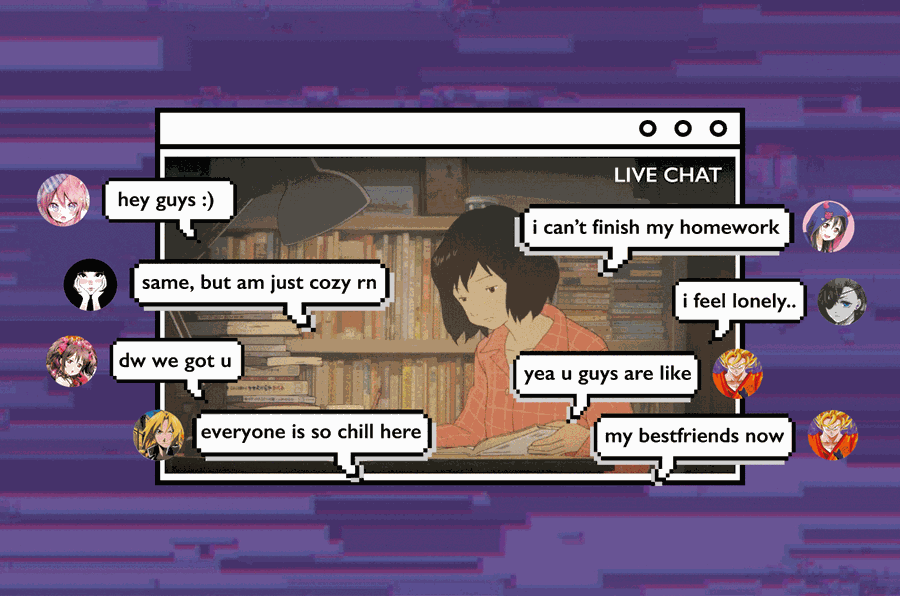If you work in a loud office or need to focus while studying for exams, YouTube’s expansive noise distraction scene can serve you well. There are already endless loops of aeroplane tones, raindrops, and combinations of white, pink, and soft brown noise to help you find peace. While these 10-hour edits may satiate some appetites, over the past few years a new set of channels, first started by amateurs and enthusiasts, have emerged that offer a music-focused approach to calm – and they’ve created some of the most uplifting environments on the internet.
When YouTube launched live-streaming in 2011, it became possible for the video platform’s corporate partners to broadcast in real-time all over the world. Two years later, they relaxed the rules over who could stream, at first favouring verified accounts with large followings, then eventually opening it up to people who could amass a simple 100 subscribers. As the rules around access loosened, an unexpected side-effect was the proliferation of 24-hour radio stations that sprang up in their dozens. These stations exist on the fringes of underground online microgenres like vaporwave or its meme-y offshoot, Simpsonswave. Stations like Chillhop Music, ChilledCow, and Mellowbeat Seeker play hazy beats paired with looped animations of depressed cartoon characters that smoke or recline just like the stoners among these stations’ listener bases. Stylistically, the stations should be recognisable to anyone familiar with internet aesthetics, from YouTube to Tumblr to different Chans, where a picture of a lethargic Bart Simpson, or an anime character with their pointed face buried in a pile of books, will converge with the colour palettes and stylised text (“C A L M R A D I O 2 4 / 7”) of vaporwave.
The majority of stations play lo-fi hip hop, or ‘chill hop’, a genre that runs introspective and jazzy old school hip hop beats through the crackly sounds of an old cassette or vinyl record. Wistful movie quotes frequently bookend the tracks on the playlists. One evening, while listening to the station, I heard a voice in a painfully desperate but familiar tone, echoing as the beat paused: “I’m lonely, mate. I’m really lonely. And I’m sad.” It served as a cue for users in the chat to talk about their own problems and swap ASLs, like the chatrooms of the early internet. The quote felt poignant and familiar, and I realised they’re the words of Russell Brand in the 2010 rager comedy Get Him to the Greek. Recontextualising the ridiculous to find a hidden poignancy is a hallmark of internet culture – vaporwave often uses elements of 80s Muzak and old infomercials, and the aesthetics of the glitchy late-90s internet, to tranquilise anthemic tracks like Toto’s “Africa”.
The supportive elements of the chatroom and the calming effects of the music were both major reasons why Neotic, a YouTube channel with over 600,000 subscribers, created their radio station. Run from Cali, Colombia by Steven Gonzalez, the channel can have thousands of listeners tuning in at any one time to listen to a playlist that includes 3000 songs, updated weekly. “I suffered many anxiety attacks, and discovered vaporwave and lo-fi hip hop, which helped to distract me,” says Gonzalez. “I started to study audio-visual production and created a specific environment to get people to speak about things like love, drugs, video games, and movies by combining visual editing with music.” Their live-streams have now amassed some 31,879,961 views.
Gonzalez’s story is not unlike childhood friends Luke Pritchard and Jonny Laxton, who started College Music in 2014 out of boarding school boredom from their bedrooms in Crowthorne, England. With their passion for underground sounds and technical knowhow, their channel has flourished. They started taking advantage of YouTube’s live-streaming feature a few years ago. “I put out my first live-stream in the summer of 2016, and it was quite unique at the time,” Pritchard explains over the phone. “I think every lo-fi hip hop artist has benefitted from the popularity of these streams.” Much like most of the channels live-streaming the genre, College Music’s most popular stream, “lofi hip hop – beats to study/relax to”, uses a looping anime that the pair commissioned as its backdrop. “Having moving visuals on a live-stream helps it to feel more ‘live’ and active, as opposed to a simple still image,” Laxton explains. “There’s definitely greater viewer engagement in the chat from these films or scenes that already have a cult following.”
The interactive chat function has proved to be the USP for these channels, and is a key driver behind the scene’s strong following – and compared to so many other social media platforms, these chatrooms are uncharacteristically friendly. “I try to sleep but I can’t,” writes one user. “I pray for your wellness brother. I might go out anytime but I want you to know that I care for you,” replies another. Most of the users that frequent the chat are high-schoolers, Gen Z music fans who missed out on the chatrooms and message boards of the early internet, which were more anonymous than the heavily personalised worlds of Instagram, Snapchat, and Twitter. The channels aren’t overrun with trolls or the obnoxiously righteous, and the channel owners add filters for bots and bring moderators on-board to keep the chat clean. “If you type anything that triggers that filter, it immediately gets removed,” Pritchard explains. “Any racism or sexism – even with dots or asterisks to separate letters – will be flagged. If you trigger a filter twice, you then get timed out. And if you do it again, you get banned.”
— Cool Shirtz (@coolshirtz) March 28, 2018
And the Grammy goes to……. Lo-Fi Hip Hop Anime Chil Beats To Study and Relax To
— 𝗱𝗮𝗿𝗹𝗶𝗻𝗴 ✩˚ (@punkzbunny) January 29, 2018
The anonymised nature of the chatroom is fitting, since for the most part, the artists in the lo-fi hip hop scene aren’t known by face and have relatively small followings. The bigger channels feature artist names on their streams, but there are some that run without obvious credit, or where you have to ask a chatbot for the track name via a keyboard shortcut. If you’re not paying attention, it’s easy to miss – the chat moves fast. Following in the footsteps of the late Japanese beatmaker Nujabes, artists like jinsang, j a r j a r, smuv, and bsd.u have paved the way and yet still remain pretty low key.
“Lo-fi is just hip hop,” says Ireland’s j a r j a r, real name Ryan O’Halloran, who got into music when he inherited the old Dance eJay 2 software and made music out of pre-prepared loops. “I think at the beginning it was about adding six different layers of vinyl crackle so that everyone thought you were a seasoned vet. Now the dust has settled, so to speak, and lo-fi is just a slightly more rugged flavour of general hip hop.” O’Halloran’s concern with the scene is that new artists try and live up to the more stereotypical elements of the genre because of the audience expectations around the YouTube streams. “My worry is that they tend to promote a certain sound, which artists will then try to emulate in order to be picked up by such streams,” he says. “In that way, a lot of artists are funnelled into the one container and things have the potential to become sort of stagnant.”
“Honestly, people find just about anything and everything to talk about there. I really feel like the people of the stream are like family, y’know” – Drippy Jo
Fortunately, Ireland has a growing live hip hop scene “bubbling below”, so aside from the streams, j a r j a r says fans in Dublin can watch acts like Kojaque and attend monthly beat battles with Cuttin’ Heads in Cork. But while the lo-fi sound has grown via live-streams, for the scene to actually flourish financially, channel owners are realising they have to take their strong online community onto other platforms too. A lot of them chat on Discord (which Luke Pritchard describes as “Slack but for nerds”) to build stronger connections to fans, while College Music set up their own label, College Music Records, around a year ago, mostly to redistribute the money being made in the now heavily saturated market for lo-fi hip hop.
“Most of the money generated from YouTube advertising should go to labels and artists, people who own the music,” the label’s Jonny Laxton explains. Pritchard adds that there are a wealth of channels that come along to “money grab”, and although some are taken down due to copyright infringement, this isn’t a long term solution. A New York Times article noted that the channel made thousands of pounds a month, but Pritchard says this doesn’t account for the amount that goes to “label royalties, claims on videos, and other costs”. He’s keen to point out that College Music is about getting artists heard, not making money.
To bring more money to the scene, channel owners understand that they have to spread the sound beyond YouTube. “When live-streams blew up, it spawned a new market on YouTube, but also outside on Spotify,” says Laxton. “Until now it’s mostly lived on YouTube, but we’ve been growing our playlist pretty quietly. Artists will get royalties from that. If we’ve put someone on our YouTube playlist, sometimes it might end up on a Spotify playlist. I think that’s quite a nice butterfly effect. But there still isn’t really a ‘scene’ – there are no gigs, for example.”
As the lo-fi live-streaming world expands beyond its ad-hoc, DIY origins, and its passionate bedroom beatmakers and channel owners turn their hobbies into careers, it’s important to remember what helped build the scene in the first place – its therapeutic community. Drippy Jo, a moderator for ChilledCow (subscribers: 1.6 million), spends a lot of their day hanging out on the stream or its Discord server. “Our similar experiences and tastes in music have brought us closer and closer over time,” they tell me over YouTube’s chat function. “Honestly, people find just about anything and everything to talk about there. I really feel like the people of the stream are like family, y’know?”


